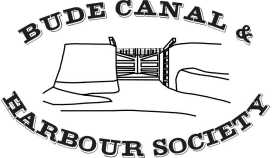| |
|
Editorial
It has been a busy summer for the Society - more accurately its committee
members.
The second Canal Day was a great success mainly due to the organisational
skills of Chris Jewell, Ann Longley, and Stan Noakes with good support
from the other committee members and two out-of-town members helping in
care and maintenance of the tub boat in the barge workshop
From June to the end of September members have manned the barge workshop
for possible visitors and on one Sunday in each of those four months a
committee member has led a walk from the sea-lock to the workshop. More
visitors than last year joined us on these occasions.
Our Events Secretary has arranged outings to Culdrose, Falmouth Maritime
Museum, and the Bodmin Wenford Railway to see work on restoring the West
Country class locomotive "Wadebridge".
back to contents
|
|
|
| |
|
|
|
|
| |
|
Canal
Day 2003
The second annual
Bude Canal Day took place o the erection of the marquee.
Stalls were manned then and on Carnival Day and RNLI weekend.
Several yachts and motor boats entered the lower basin via the sealock
largely due to publicity by the society.
Prodding by the committee led to the dredging of the waste material in
the canal round the upper lock gates left by the gate installers. Progress
is being made slowly in obtaining promises of funds for the update of
the canal and on Sunday 27th July and this year incorporated a celebration
of the life of Sir Goldsworthy Gurney, “Bude’s Forgotten Genius”.
The event, jointly organised by your Committee and Bude-Stratton Town
Council, was held in order to raise awareness of the area's rich history,
to encourage use of the canal and sea lock and to further inform the public
about the proposed Canal Regeneration and Limelight projects.
A marvellous day preceded by heavy rain two days before, ensuring sufficient
water in the canal to use the sea lock if boats arrived, and cloud and
sunny intervals with little wind on the day combined to make it a great
success.
Your committee began by erecting a marquee with the help of other members,
and your editor and Events Secretary with the aid of the instruction leaflet
put up a new smaller gazebo, in which Friggin Riggin and the Jays performed
later, and the united committee dealt with our new larger gazebo in record
time thanks to the ingenious construction.

Capt. G. A. Hogg RN, trustee of the National Maritime Museum Cornwall,
opened the day with an address that praised the organisers for their efforts
and encouraged those present to “go out, enjoy, and remember the
past”.
The whole day was well attended with crowds of people enjoying a variety
of activities - from a children’s painting competition to the locking
in of several vessels through Bude’s recently restored sea lock.
The canal is an important aspect of Bude’s heritage and still supports
a wide range of activities, as was illustrated by a Bude Canal Angling
Association competition, a Canoe Polo match and a minuet yacht demonstration.
Sir Goldsworthy Gurney (1793 – 1875), inventor of the Bude Light
- a lighting system used in the Houses of Parliament, was an early pioneer
of steam power. Fittingly, a celebration of steam took place in the grounds
of The Castle, which was built as a home by Goldsworthy Gurney in 1830.
The Trevithick Society operated a fascinating steam powered replica of
the ‘Puffing Devil’ - the worlds first successfully self-propelled
vehicle. A unique steam powered bicycle - literally ‘steaming’
around the castle grounds - also generated much interest, as did a Goldsworthy
Gurney exhibition in the Parkhouse Centre.

The soundtrack to the day was provided by music from Friggin Riggin,
The Jays, Bude Metric Band, Bude Town
Band and a traditional fair organ. Children from Whitstone Primary School
danced to The Cavaliers and Bude Junior School preformed a ‘Mini
Wreckers’ broomstick dance. Festivities continued into the night
with a concert at the Falcon hotel featuring Phil Williams and Sarah Deere-Jones
supported by Friggin Riggin.
Other attractions included, a display of model boats and restored reed
cutting boat as well as representation from organisations such as Bude
Motor Club, The Bude Pilot Gig Club, Bude Surf Life Saving Club, The Old
Cornwall Society, The North Devon Maritime Museum, North Cornwall District
Council, The Environment Agency, South West Lakes Trust, Grand Western
Canal Trust and the Rolle Canal Society.
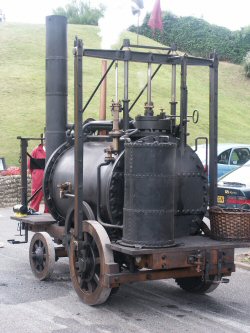 A
children’s painting competition depicting local landmarks received
many entries of a high standard. The winners were: Juniors – 1st
Luke Stephenson, 2nd Lucy Reagan. Infants – 1st Emily Barker, 2nd
Tom Cappleman–Lynes. Any winners who were not present for the award
giving should call Anne Longley on (01288 353 839) to claim their prize!
A selection of the paintings are currently on display in Bude-Stratton
Museum (situated on the Lower Wharf). A
children’s painting competition depicting local landmarks received
many entries of a high standard. The winners were: Juniors – 1st
Luke Stephenson, 2nd Lucy Reagan. Infants – 1st Emily Barker, 2nd
Tom Cappleman–Lynes. Any winners who were not present for the award
giving should call Anne Longley on (01288 353 839) to claim their prize!
A selection of the paintings are currently on display in Bude-Stratton
Museum (situated on the Lower Wharf).
The Bude Canal Angling
Association competition was won by Simon Allen with a catch of 9lb 7 ½
oz. He was presented with ‘The Falcon Cup’ by Mr Tim Browning
of the Falcon Hotel, Bude. In second place was Brian Powell (with a catch
of 8lb 8oz), joint third place was shared by Nathan Underwood and Adrian
Hill (who both landed catches of 8lb 6oz). The Canoe Polo competition
for the Bude Canal & Harbour Society Shield was won by Bude Canoe
Club, with Adventure International as runners up.
For much of the above we are indebted to Mary Myers' report to local papers.
back to contents
|
|
|
| |
|
|
|
|
| |
|
RNLI
weekend 22/25 August 2003
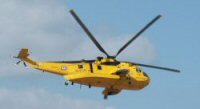 Your
committee erected the new gazebo on the Saturday and Sunday at the Bark
House green to set up our stall. Six peopl;e are required for this operation:
one at each corner of this ingenious structure and one in the middle of
each long side. On the word of command all walk backwards and outwards
to the full stretch of the metal supports and then each releases a button
and extends each leg (of the gazebo - not the operator). This takes about
three minutes now that the team is becoming efficient. After that one
or two can drive in the pegs and attach the guy ropes and the edifice
is secure. The same number are required for the dismantling. Much more
time is required to fetch and set uip tables and display the wares nd
then to man the stall. No doubt the Treasurer's report will indicate the
amount of profit made at this venue. Your
committee erected the new gazebo on the Saturday and Sunday at the Bark
House green to set up our stall. Six peopl;e are required for this operation:
one at each corner of this ingenious structure and one in the middle of
each long side. On the word of command all walk backwards and outwards
to the full stretch of the metal supports and then each releases a button
and extends each leg (of the gazebo - not the operator). This takes about
three minutes now that the team is becoming efficient. After that one
or two can drive in the pegs and attach the guy ropes and the edifice
is secure. The same number are required for the dismantling. Much more
time is required to fetch and set uip tables and display the wares nd
then to man the stall. No doubt the Treasurer's report will indicate the
amount of profit made at this venue.
The devotion of this small number was repaid when Anne Longley and David
Phillips provided pasties and beer or wine on the patio of their lovely
home in Breakwater Road while we watched the fireworks so thoughtfully
supplied by the RNLI.
During Monday four gigs rowed from Port Isaac arrived and locked in to
the Lower Basin to join Windthief, Quando and Moderation. Chris Jewell,
David Phillips and two other Society members, Alan Hawkins and John Harris,
were in the lock operating crew. Another member, Malcolm Mitchell, is
also a regular volunteer.
|
|
|
| |
|
|
|
|
| |
|
Bude
Canal Inclined Plane Rails
Bryan Dudley Stamp writes:
 Mrs
Philippa Fitzpatrick, Curator of the Bude Museum on the Lower Wharf, has
been asking if the vertical rails used for the canal overflow close to
the museum are ex-inclined plane rails. Mrs
Philippa Fitzpatrick, Curator of the Bude Museum on the Lower Wharf, has
been asking if the vertical rails used for the canal overflow close to
the museum are ex-inclined plane rails.
On inspection one can see that they are, indeed, U-shaped rails used back
to back.
Knowing that rails have been used as lintels at Box's Foundry at Marhamchurch
I paid it a recent visit. There is, indeed, a storage building at the
top end of the foundry adjacent to the Marhamchurch inclined plane where
two U-shaped rails have been used. They appear to be the same size as
those used on the canal overflow.
I have asked Gerald Fry, Restorations Manager for the Bude Canal Trust,
for his comments. He says that both U-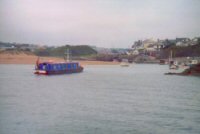 shaped
and L-shaped rails have been unearthed at the Veeland inclined plane on
the Bude Canal aqueduct. This would seem to suggest that both types of
rail were used on the inclines: possibly the U-shaped on the right and
the L-shaped rail on the left going up. Or it could be that U-shaped rails
were used at both the top and bottom ends of the plane to guide the tub
boat wheels on to the L-shaped rails used higher up. shaped
and L-shaped rails have been unearthed at the Veeland inclined plane on
the Bude Canal aqueduct. This would seem to suggest that both types of
rail were used on the inclines: possibly the U-shaped on the right and
the L-shaped rail on the left going up. Or it could be that U-shaped rails
were used at both the top and bottom ends of the plane to guide the tub
boat wheels on to the L-shaped rails used higher up.
As there are no known drawings or plans of the planes in existence it
is all a matter of conjecture.
Nevertheless, perhaps some of our readers may have further comments.
Chris Jewell points out that although David Tew's book "Canal Inclines
and Lifts" is silent on the shape of the rails, there is what is
described as a contemporary drawing of the type of wheeled boat used on
the Bude Canal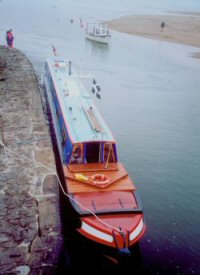 sitting on a pair of L-shaped rails.
sitting on a pair of L-shaped rails.
He shares the view expressed above that channel rails were used at top
and bottom to guide the wheels into the L-shaped rails used above and
below.
On page 154 of "The Canals of South West England" Charles Hadfield
says of the Bude Canal, "They (tub boats) were
fitted with small wheels of 14in diameter which projected from the sides,
and ran in channel rails on the inclined planes..." The word 'channel'
implies a U-shape. Ed.
back
to contents
The
Bude Canal tub boat
Recently, the Bude Stratton Town Council , which has the tub boat on loan
from ISCA, has had Dr Bleu, a marine archaeologist from the Centre of
Marine Archaeology at Southampton University, visit Bude to look at the
tub boat. Her initial comments are that the boat is in reasonable conditions
and is being kept so. It is important that BSTC are treating the boat
with the significance that it deserves. Dr Bleu will be making another
visit with a conservator to do a detailed report on the boat.
The council has recently been offered the ownership of the tub boat by
ISCA, its owners, for the sum of £1 with the condition that they
be offered the boat first should the council ever decide to dispose of
it.
This is an important development as it will allow BSTC to make grant applications
for funds to cover the various works known to be needed plus any matters
identified by Dr Bleu's detailed examination.
It has been agreed that any funds over £1,000 in the Society's Project
Fund be dedicated towards any match funding needed for any such project.
Chris Jewell
back to contents

|
|
|
| |
|
|
|
|
| |
|
Bude
Canal Project
Since issue 23 there have been two meetings of the Bude Canal Partnership
led by North Cornwall District Council, the latest being on the 10 July
2003 The main matters of interest are as follows:
i confirmation of an offer letter for just under $1m
from South West Regional Development Agency
ii An offer letter from Intereg (European Regional Fund)
for £95,000.
This is a complementary grant and not part of the main applications.
It will be used to establish walking routes as recommended in the consultants'
final report, these being the completion of the Tamar Trail, a long distance
walk, a circular 20 mile walk,and three short circular walks in the Holsworthy
area. All of these walks will utilise, where possible, the towpaths of
the canal.
The grant is for immediate use and needs to be spent by the end of the
year 2005. As well as the physical implementation of the routes it will
cater for signage, interpretation, leaflets, and a website which can include
the Barge Canal section between Bude and Helebridge.
This funding can also be used as complementary for both the Objective
1 and Heritage Lottery Fund bids.
iii Planning applications for works on the Barge canal
section. There are 18 items in the applications which range from landscaping
works and restoration of the inland locks, to the slightly more controversial
building of four workshops on the Barkhouse Green.. This is necessary
to show an "economic output", ie jobs for the Objective 1 bid
and to provide NCDC with a source of income for the future maintenance
of the canal. The initial proposed design for these workshops raised concerns
about the loss of "through views". This has been communicated
by the Society and Bude Stratton Town Council to NCDC in a meeting on
4 August 03. The design of those  workshops
is now under urgent review to find an acceptable alternative as it is
crucial to have local support and to achieve planning consent so that
the bid applications can be submitted by the end of September 2003. workshops
is now under urgent review to find an acceptable alternative as it is
crucial to have local support and to achieve planning consent so that
the bid applications can be submitted by the end of September 2003.
iv If all goes well and there is no more slippage in the timescale and
the funding is secured, capital works should commence in February 2005
on the Barge canal with an expected conclusion of all works by December
2007.
Once done this will breathe new life into the canal corridor by an improved
environment for residents and visitors alike making Bude an even better
place in which to live or visit.
Chris Jewell
back
to contents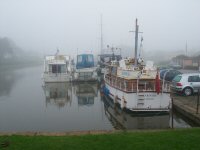 |
|
|
| |
|
|
|
|
| |
|
"Wadebridge" 34007
Led by Society member, Fred Copeland, a party of enthusiastic members
visited Bodmin in september to see the progress being made on the Locomotive
Restortion Project of one of Southern Railway's Light Pacific engines,
"Wadebridge". This is the earliest "West Country Class"
steam locomotive still in existence.
The party were shown the engine's boilet undergoing repair and its frame
being assembled at the workshops at Bodmin General station. It is hoped
that the engine will be completed in 2004.
In addition the engine workshops of the Bodmin Wenford Railway were also
inspected.
One delight was the eight-year old boy clad in overalls and a good coating
of soot who announced proudly that he was the only one small enough to
enter the firebox to clean it.
To round off a most interesting and sunny day, there was a trip to Bodmin
Parkway and back (albeit by diesel engine). Certainly a good time was
had by all.
Bryan Dudley Stamp.
back
to contents
Bude
in 1813
The following extract
is from "Voyage Round Great Britain Vol 1" written by Richard
Ayton in 1813 and published in 1814, six years before the first sod was
cut on the Bude Canal.
"This place is called Bude Haven, though at present only a sandy
creek, where small vessels venture to ground, and are so exposed to the
wind and sea, that they have a fair chance of having their bottoms knocked
out by every returning tide. It was once a large and commodious port,
all traces of which are now buried under the sand. The river Bude meets
the sea here, and at its confluence formerly spread into a wide estuary,
capable of receiving ships of great burden, but now runs to the sea in
a shallow stream, navigable only for ducks and geese. The destruction
of the haven is attributed both to the sand from the sea and the mud from
the river; the first imbankment was of sand, which obstructed the mud
in its passage to the sea, and co-operated with it in filling up the channel
of the haven. But though Bude has at present no title to the character
of a harbour, it is still frequented as a port, in consideration of what
it was formerly, and greatly to the emoluments of the shipwrights. I saw
several vessels moored on the sand, and was so struck with their evident
exposure, that I could not forbear from expressing my opinion of their
danger to some of the captains: but they all explained to me the cause
of their situation by observing, and that too in a tone of justification,
that Bude was once as good a harbour as any on the coast of Cornwall.
I have never seen the game of follow-my-leader more desperately pursued.
The village of Bude is very small but has some neat houses in it, which
are let out as lodgings to visitors, who go thither for the benefit of
sea-bathing, though the place is not supplied with any conveniences that
can render the act of bathing either comfortable or decent, particularly
to the ladies. No bathing machines are employed, and consequently the
ladies are reduced to the necessity of undressing themselves in the dark
and dismal caverns hollowed in the cliffs by the sea, and of parading
into the water not unseen. At the precise moment which they choose for
their dip, some male starers are certain to be picking up shells at the
water's edge, who, under this pretence, have an opportunity of seeing
the whole exhibition.
There is no circulating library or trinket shop at Bude, where the visitors
can spend their money and their mornings, so that, in spite of the bracing
effects of the cold bath, I think I discovered some symptons of flaccidity
about them, and a certain anxiety in their countenances which declared
that they were seeking more than they could find. I have heard some seamen
say that they preferred a storm to a calm, and I confess that beating
hemp would be more to my taste than waiting three and twenty hours every
day for a plunge in the sea.
(An earlier "Tub Boat" gave an acount by a lady of the difficulties
of bathing towards the end of the 19th century, and another describing
ships unloading at the Strand by Grenville's cottage in the 17th century
but it was not clear that Bude was a "large port". Ed)
|
|
|
| |
|
back
to contents
Contact
the Society |
|
|
